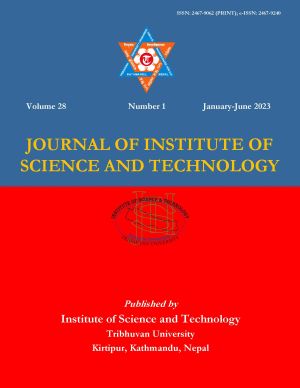Application of Geospatial Techniques for Artificial Recharge to Groundwater in Ratu Khola Watershed, Central Nepal
DOI:
https://doi.org/10.3126/jist.v28i1.47459Keywords:
Artificial recharge pond, analytical hierarchy process, Ratu Khola watershed, SiwalikAbstract
Water levels in many existing ponds and shallow tube wells are found lowering day by day in the Bhabar and Terai regions of Nepal. For the sustainable management of the groundwater, development of artificial recharge ponds is considered the best approach in this region. The suitable site selection for the artificial recharge ponds requires surface as well as sub-surface geological investigation along with other land use-related characteristics. The study area is a part of the Ratu Khola watershed in the Mahottari and Dhanusa districts and encompasses parts of the Siwalik, Bhabar, and Middle Terai regions from an aspect of the geological division. The present study has aimed to find suitable sites for the artificial recharge pond. For this purpose, extensive fieldwork was carried out to gather data related to geology, geomorphology, water table, and soil characteristics. However, slope and drainage density maps were developed from the Digital Elevation Model (DEM). The thematic layers of different parameters such as geology, geomorphology, slope, water table, drainage density, land use land cover, and soil type were prepared by using GIS and RS. Based on the field data and prepared maps the suitable sites for artificial recharge ponds were analyzed. The Analytic Hierarchy Process (AHP) method was adopted to assign rank and reclassify the prepared maps. The total area was differentiated into five classes to assess the suitable sites for artificial recharge ponds. These five classes are named as the most suitable, highly suitable, moderately suitable, low suitable, and unsuitable depending on the score of the suitability analysis. The most suitable, highly suitable, moderately suitable, low suitable, and unsuitable area for groundwater recharge is found at about 3%, 7%, 24%, 32%, and 34% respectively. Finally, the ROC/AUC curve was prepared using primary data (point data) collected from the field. An overall accuracy of 82.3% was achieved in this study and is considered satisfactory.
Downloads
Downloads
Published
How to Cite
Issue
Section
License
Copyright (c) 2023 Institute of Science and Technology, T.U.

This work is licensed under a Creative Commons Attribution-ShareAlike 4.0 International License.
The views and interpretations in this journal are those of the author(s). They are not attributable to the Institute of Science and Technology, T.U. and do not imply the expression of any opinion concerning the legal status of any country, territory, city, area of its authorities, or concerning the delimitation of its frontiers of boundaries.
The copyright of the articles is held by the Institute of Science and Technology, T.U.




